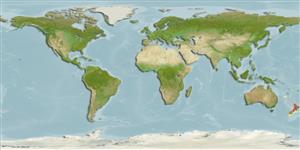Elasmobranchii (Haie und Rochen) (sharks and rays) >
Myliobatiformes (Stingrays) >
Myliobatidae (Eagle and manta rays)
Etymology: Myliobatis: Greek, mylo = mill + Greek, + Greek, batis,-idos = a ray (Raja sp.) (Ref. 45335).
Environment: milieu / climate zone / depth range / distribution range
Ökologie
seewasser; brackwasser benthopelagisch; tiefenbereich 0 - 160 m (Ref. 26346). Temperate
Southwest Pacific: Norfolk Island and New Zealand, including the Kermadec Islands.
Size / Gewicht / Alter
Maturity: Lm ? range ? - ? cm
Max length : 150 cm WD Männchen/unbestimmt; (Ref. 12951); common length : 100.0 cm TL Männchen/unbestimmt; (Ref. 9258)
Kurzbeschreibung
Bestimmungsschlüssel | Morphologie | Morphometrie
Olive-green, yellow or dark brown dorsally with pale blue or grey markings; white ventrally (Ref. 26346). No caudal fin (Ref. 26346).
Occurs in bays, estuaries, and near rocky reefs (Ref. 12951). Usually solitary (Ref. 12951). Feeds on clams, oysters, worms, and crabs (Ref. 12951). Ovoviviparous (Ref. 50449). Although the spine on the tail is capable of inflicting a painful wound, the poison is quickly neutralized by immersion of the injured area in hot water (Ref. 26346).
Life cycle and mating behavior
Maturities | Fortpflanzung | Spawnings | Egg(s) | Fecundities | Larven
Exhibit ovoviparity (aplacental viviparity), with embryos feeding initially on yolk, then receiving additional nourishment from the mother by indirect absorption of uterine fluid enriched with mucus, fat or protein through specialised structures (Ref. 50449). Young are born at less than 50 cm (Ref. 26346).
Francis, M.P., 1993. Checklist of the coastal fishes of Lord Howe, Norfolk, and Kermadec Islands, Southwest Pacific Ocean. Pac. Sci. 47(2):136-170. (Ref. 8879)
IUCN Rote Liste Status (Ref. 130435)
Nutzung durch Menschen
Fischereien: weniger kommerziell
Tools
Zusatzinformationen
Download XML
Internet Quellen
Estimates based on models
Preferred temperature (Ref.
123201): 14.4 - 19.8, mean 16.6 °C (based on 74 cells).
Phylogenetic diversity index (Ref.
82804): PD
50 = 0.5002 [Uniqueness, from 0.5 = low to 2.0 = high].
Bayesian length-weight: a=0.00389 (0.00123 - 0.01235), b=3.08 (2.82 - 3.34), in cm total length, based on LWR estimates for this (Sub)family-body shape (Ref.
93245).
Trophic level (Ref.
69278): 3.5 ±0.4 se; based on size and trophs of closest relatives
Widerstandsfähigkeit (Ref.
120179): niedrig, Verdopplung der Population dauert 4,5 - 14 Jahre. (Fec assumed to be <100).
Fishing Vulnerability (Ref.
59153): Very high vulnerability (83 of 100).
Nutrients (Ref.
124155): Calcium = 3.64 [0.51, 61.12] mg/100g; Iron = 0.186 [0.018, 2.244] mg/100g; Protein = 19.8 [14.5, 25.0] %; Omega3 = 0.327 [0.095, 0.951] g/100g; Selenium = 14.3 [2.7, 79.6] μg/100g; VitaminA = 4.82 [0.41, 52.01] μg/100g; Zinc = 0.407 [0.030, 4.511] mg/100g (wet weight);
